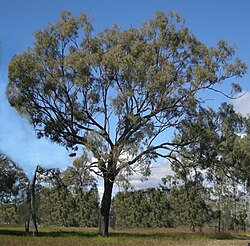Eukalypten
| Eukalypten | ||||||||||||
|---|---|---|---|---|---|---|---|---|---|---|---|---|
 Eucalyptus scoparia | ||||||||||||
| Systematik | ||||||||||||
| ||||||||||||
| Wissenschaftlicher Name | ||||||||||||
| Eucalyptus | ||||||||||||
| L’Her. |
Die Eukalypten (Eucalyptus), auch Blaugummibäume genannt, sind eine artenreiche Pflanzengattung in der Familie der Myrtengewächse (Myrtaceae). Die über 600 Arten sind in Australien und Indonesien heimisch.
Beschreibung


Habitus
Die meisten Eukalyptusarten sind schnellwüchsige, oft hohe, immergrüne Bäume und Sträucher (beispielsweise Eucalyptus vernicosa aus dem westlichen Tasmanien). Der Riesen-Eukalyptus (Eucalyptus regnans) gilt als der Laubbaum mit der zweithöchsten Wuchshöhe, knapp nach dem Gelben Meranti.[1] Das größte derzeit lebende Exemplar dieser Art, der etwa 400 Jahre alte „Centurion“, wurde mit einer Wuchshöhe von über 99 m und einem Stammumfang von bis zu 12,7 Metern auf Tasmanien gemessen.[2] Im 19. Jahrhundert gab es sogar noch größere Exemplare in den australischen Wäldern.[3]
Borke und Rinde
Das Erscheinungsbild der Rinde von Eukalyptusbäumen ändert sich im Laufe des Alters. Wie andere Bäume auch setzen Eukalyptusarten jährlich eine neue Schicht Borke an und erweitern so ihren Stammesumfang. Bei manchen Arten stirbt die äußerste Schicht ab und löst sich darauf in langen Streifen (wie bei Eucalyptus sheathiana) oder in unterschiedlich großen „Flocken“ (Eucalyptus diversicolor, Eucalyptus cosmophylla oder Eucalyptus cladocalyx) vom Baum. Bei vielen Arten kann die tote Rinde jedoch einfach am Baum verbleiben. Durch die Witterungseinflüsse bekommt diese Rinde ihr typisches, alterndes Aussehen. Viele andere Arten sind auch als sogenannte half-barks und blackbutts bekannt, was darauf anspielt, dass bei diesen Arten die abgestorbene Borke nur im unteren Bereich des Stammes oder als große, schwarze Ansammlung direkt am Fuß des Baumes behalten wird. Die glatte, obere und jüngere Rinde der half-barks und die Rinde anderer glattrindiger Eukalyptusarten können bemerkenswerte und höchst interessante Farben annehmen (wie beispielsweise bei Eucalyptus deglupta).
Blätter
Die Jugendblätter und die Blätter an älteren Bäumen unterscheiden sich bei den meisten Arten deutlich (Heterophyllie). Zum Beispiel sind die Jugendblätter gegenständig – die adulten Blätter wechselständig und oft sind die adulten Blätter sichelförmig oder herz-eiförmig. Meist sind die Blätter ledrig. Die Blattspreite ist oft um 90° gedreht, um weniger Angriffsfläche für die hohe Sonneneinstrahlung zu bieten.
Blütenstände, Blüten und Früchte
Die doldigen und oft zusammengesetzten Blütenstände enthalten oft viele Blüten.
Die zwittrigen, radiärsymmetrischen Blüten sind vier- bis fünfzählig. Während des Knospenstadiums ist die Blüte von einem Deckel, „Operculum“ (Calyptra) genannt, bedeckt, welcher aus den verschmolzenen weniger auffälligen Blütenhüll- und/oder Kelchblättern besteht, die verschmolzenen Kelch- und Kronblätter können aber auch getrennt sein und zwei übereinanderliegende, innere (petaline) und äußere (sepaline) Operculi bilden. Der äußere Rand der Abrissstelle des Operculums wird „Calycine Ring“ genannt, er ist mehr oder weniger stark ausgeprägt. Statt auffälliger Blütenhüllblätter enthalten die Blüten eine große Anzahl (20 bis 150) an langen, meist freien Staubblättern in mehreren Kreisen, die auf dem mehr oder weniger breiten Stamino- oder Stemonophor (Staubfadenträger) an der Innenseite des Calycine Rings sitzen, welche in ihrer Farbe je nach Art weißlich, rötlich, oder gelb sein können. Manchmal ist nur ein Teil der Staubblätter fertil und es sind dann Staminodien vorhanden. Die Blüte ist also nicht mit den Blütenhüllblättern, sondern mit den Staubgefäßen geschmückt, dies kommt bei unterschiedlichen Blütenpflanzentaxa vor. Wenn die Blüte sich öffnet, werden die Staubgefäße erweitert und das Operculum wird abgesprengt. Die botanische Bezeichnung „Eucalyptus“ leitet sich vom Operculum und dessen Funktion ab. Zwei bis sieben Fruchtblätter sind zu einem halbunterständigen oder unterständigen, mehrkammerigen Fruchtknoten und einem gemeinsamen Stempel mit kopfiger Narbe verwachsen. Der Blütenboden ist manchmal gerippt. Die Bestäubung erfolgt durch Insekten (Entomophilie) oder Vögel (Ornithophilie). An der Innenseite des Staminophors liegt der Diskus, dieser kann eingedrückt, flach oder vorstehend sein.
Angophora-Arten unterscheiden sich leicht von anderen Eucalyptus-Arten in den Blüten, durch die Anwesenheit von vier oder fünf dreieckigen Blütenblättern mit grünem Kiel und weißem Rand und durch beständige, holzige, grüne Sepalen. Sie sind also ohne Operculum, weil die Petalen hier bedeckende „Klappen“ bilden, die sich dann öffnen und die Staubblätter freilegen. Der Calyx kann hier auch bespitzt sein.
Die oft holzigen, trockenen Kapselfrüchte, in englischer Sprache auch Gumnuts genannt, sind meistens kegel- oder urnen- bis birnenförmig und besitzen an ihren oberen Enden meist vier (3–7), oft dreieckige, mehr oder weniger vorstehende oder eingesenkte, ventilartige, nach außen öffnende Öffnungen, Klappen, die geöffnet die eigentlichen, sehr kleinen Samen freigeben. Die Kapseln einiger Arten öffnen sich nur nach Bränden, bei Eucalyptus pleurocarpa sind die Kapseln weiß und rippig. Die Früchte sind sehr verschieden in der Größe, sie können von 0,2 cm bis zu 7 cm groß sein, meist sind sie etwa 0,5 bis 1 cm groß. Die unregelmäßig geformten Samen können manchmal geflügelt sein und sind braun, rötlich, gelblich, grau oder schwarz. Die sterilen, unbefruchteten oder unfruchtbaren, meistens kleineren und andersfarbigen Eizellen werden „Chaff“ genannt, sie sind oft in großer Zahl, bis zu über 90 %, vorhanden. Es sind oft 4 bis 10 fertile Samen vorhanden, es können aber 30 oder viel mehr sein oder auch nur zwei. Die Samen werden durch den Wind verbreitet. In wenigen Arten öffnen sich die Kapseln erst nach einigen Jahren. Das Vorhandensein des Chaffs macht die Lagerung der Samen teuer und das genaue Aussäen sehr schwierig, die fertilen Samen und der Chaff können durch Aussieben getrennt werden. Einige Samen benötigen Feuer, um zu keimen.
- Blütenstand von Eucalyptus blakelyi
- Man sieht die abfallende Kalyptra bei den Blüten von Eucalyptus tereticornis
- Früchte von Eucalyptus globulus
- Samen von Eucalyptus camaldulensis
Verbreitung

Eukalypten haben ihre Heimat in Australien, inklusive Tasmanien und der Osthälfte Indonesiens. Heute aber wachsen manche Arten auch in vielen anderen tropischen und subtropischen Gebieten der Welt. In Australien besteht der Baumbestand heute zu 70 % aus Eukalyptusarten. Kein anderer Kontinent hat einen so stark von einer einzelnen Gattung dominierten Baumbestand. Die Fläche des natürlichen Eukalyptus-Bestandes in Australien beträgt mehr als 110.000 km² (Stand 2009).[4]
In mehreren Weltregionen, in denen Eukalyptus-Arten nicht heimisch sind, wird Eukalyptus wegen seiner Schnellwüchsigkeit und guten Holzqualität angebaut. Beispiele für solche Regionen sind Südeuropa und Südafrika. Eukalyptus-Arten werden in mehr als 90 Ländern auf einer Fläche von insgesamt mehr als 220.000 km² angebaut,[4] das ist das Zweifache der Fläche mit natürlichem Eukalyptuswald in Australien.
Die Fläche der Eukalyptus-Plantagen entspricht etwa zwölf Prozent der Fläche aller Forste und Holzplantagen und etwa 0,5 Prozent aller Waldflächen weltweit (Stand 2009).[4] Auf etwa 130.000 km² (das sind knapp 60 Prozent der gesamten Eukalyptus-Plantagenflächen) ist die Produktivität hoch genug, damit sie den Anforderungen der Holzindustrie genügt (Stand 2009); die restliche Plantagenfläche wird als „unproduktiv“ bewertet.[4]
Ökologie
Futterpflanze
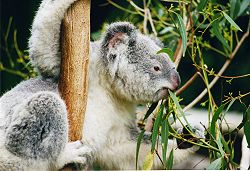
Eukalypten sind die Futterpflanzen des Koalas und einiger anderer Beuteltiere. Für die meisten anderen Tierarten sind sie dagegen giftig und nutzlos. Auch die Koalas fressen bevorzugt alte Blätter, in denen die Giftstoffe nicht mehr so konzentriert sind wie in den jungen Trieben und Blättern.
Auswirkungen im Ökosystem
Der Anbau von Eukalyptus führt häufig zu Problemen, weil er den Boden bis in die Tiefe austrocknet, den heimischen Tieren keinen Lebensraum bietet, andere Pflanzenarten aggressiv verdrängt und die Waldbrandgefahr verstärkt. In verschiedenen Regionen haben sich die durch Eukalyptus angefeuerten, intensiveren Waldbrände negativ auf die heimische Fauna ausgewirkt, den Nährstoffgehalt der Böden verringert und zu stärkerer Bodenerosion geführt.[5][6] Mit Programmen wie Working for Water werden unter anderem Eukalypten gezielt entfernt, um vor allem die Schäden, die sie im Wasserhaushalt einzelner Regionen verursachen, zu beseitigen.[7]
Waldbrandgefahr
Eukalyptus spec. fördert mit seinen hochbrennbaren Ölen Wahrscheinlichkeit und Intensität von Waldbränden. Einige der forstwirtschaftlich im Mittelmeerraum genutzten Eukalyptus-Arten geben auch ölige Substanzen in den Boden ab, wodurch sich die Waldbrandgefahr weiter erhöht.[8] Der „Eukalyptus“ hat auch die Eigenschaft, von Zeit zu Zeit große Äste abzuwerfen. Die am Boden liegenden Äste sind besonders förderlich bei Waldbränden, denn sie führen das Feuer näher an den Baum heran.
Eukalyptus-Arten profitieren von Waldbränden, da ihre Wurzelstöcke und Samen ein Feuer überleben und sehr schnell wieder austreiben, bevor sich andere Pflanzenarten erholt haben. Das Feuer ist für sie im Wettbewerb mit anderen Waldpflanzen in der Gesamtbilanz positiv,[9] denn es dient nicht nur der Beseitigung von Parasiten, sondern hilft dem Eukalyptus bei der Fortpflanzung (Pyrophilie). Besonders durch die hohe Hitze des Feuers können die Samenschalen des Baumes platzen. Viele Eukalyptus-Arten bilden sogenannte Lignotuber aus, die ein Wiederaustreiben auch nach völliger Zerstörung der oberirdischen Pflanzenteile ermöglichen.
Bei den Waldbränden in Portugal 2017 wurde seitens der Umweltschutzorganisation Quercus kritisiert, dass die Behörden den Anbau von Eukalypten gefördert hatten und überwiegend Eukalyptusbestände gebrannt hätten.[10]
Nutzung
Holz
Eukalypten dienen in erster Linie zur Holzgewinnung.[11] Von den rund 700 Arten kommen 37 Arten für die Verwendung in der Holzindustrie in Frage, jedoch werden nur 15 Arten tatsächlich kommerziell genutzt.[12]
Alle Eukalyptusholzarten sind rötlich. Die drei wichtigsten Holzarten sind[13]:
- Eucalyptus camaldulensis (Roter Eukalyptus – Red Gum): hartes, schädlingsresistentes Holz, eingesetzt für Parkett, Trittflächen, Furnier und hochwertige Möbel, wird mit der Zeit dunkelrot
- Eucalyptus grandis (Flooded Gum): weniger hart, für Möbel, Boote, Sportgeräte, Leitern
- Eucalyptus globulus (Blauer Eukalyptus – Blue Gum): schwer zu verarbeiten, nicht termiten- und pilzresistent, etwas rotbraun
Eukalyptus ist der weltweit am meisten verbreitete Plantagenbaum.
Eukalyptusöl

Mehr als 50 Eukalyptusarten dienen zur Gewinnung stark riechender ätherischer Öle mittels Wasserdampfdestillation der Blätter und Zweige. Die chemische Zusammensetzung und die physiologische Wirkung der ätherischen Öle hängen von der Eukalyptusart ab. Welche Eukalyptusart sich im Fläschchen befindet, darüber gibt der botanische Name Auskunft.
Unter dem Namen des bekanntesten Vertreters Blauer Eukalyptus (Eucalyptus globulus) finden sich auch Vermischungen mit anderen Eukalyptussorten, da nach dem Europäischen Arzneibuch verschiedene Arten zur Gewinnung des Eukalyptusöls herangezogen werden dürfen. Auch wird Eucalyptus globulus rektifiziert, das heißt, es wird mittels einer Nachdestillation der Anteil der stark reizenden Inhaltsstoffe abgesenkt. Aus diesem Grund sollte der Gehalt des Cineols in Prozent auf dem ätherischen Ölfläschchen stehen.
Die unterschiedlichen Eukalyptusarten eignen sich wegen ihrer Inhaltsstoffe nicht für Kinder unter sechs Jahren und auch nicht für die meisten Tiere. In großen Mengen sind sie auch für erwachsene Menschen giftig. Eukalyptusöl findet eine Anwendung in der Bienenpflege als Wirkstoff gegen Milbenbefall.
Inhaltsstoffe verschiedener Eukalyptus-Arten:
- Blauer Eukalyptus (Eucalyptus globulus) – je nach Rektifikation zwischen 60 und 85 % 1,8-Cineol, 25 % Monoterpene, Sesquiterpenole, Sesquiterpene, Monoterpenole, Monoterpenketone und Ester.
- Zitroneneukalyptus (Corymbia citriodora Syn. Eucalyptus citriodora) – 70 % Aldehyde, 25 % Monoterpene, Sesquiterpene, Phenole und Ester.
- Pfefferminz-Eukalyptus (Eucalyptus radiata) – 80 % Oxide, 10 % Monoterpene, Monoterpenole, Aldehyde und Sesquiterpene.[14]
Energiepflanze
Die schnell wachsenden Eukalypten haben eine zunehmende Bedeutung als Energiepflanze, wobei durch Pyrolyse aus dem Holz gewonnenes Gas und Öl sowie Holz zur Verbrennung in Wärmekraftwerken genutzt wird. Wegen des hohen Flächenbedarfes und weiterer Probleme sind solche Projekte teilweise umstritten.[15]
Systematik
Botanische Geschichte
Zum ersten Mal schriftlich erwähnt wurde die Gattung Eucalyptus auf der Forschungsreise von Abel Tasman im Jahre 1642. Er fand in Tasmanien ein Gebiet, auf dem Bäume wuchsen, die ihre niedrigsten Äste in 18 m Höhe hatten. Auch der Forscher Dampier fand diese Bäume zu späterer Zeit, als Tasmanien New South Wales genannt wurde. Er nannte den Eukalyptus „Drachenbaum“ wegen seiner enormen Größe und der erhöhten Ausscheidung von Harz. Auch der Entdecker Captain James Cook verglich dieselben Bäume 1770 mit „Harz-Drachen“. Joseph Banks, ein bekannter Botaniker, begleitete James Cook auf seiner Überfahrt und brachte die Pflanzen mit zurück nach England.[16] Die Gattung Eucalyptus wurde dann 1789 vom französischen Botaniker Charles Louis L’Héritier de Brutelle, in der Zeit, als er in London arbeitete, mit der Erstveröffentlichung der Art Eucalyptus obliqua in Sertum Anglicum, S. 11, Tafel 20 aufgestellt.[17] Der Gattungsname Eucalyptus setzt sich aus den altgriechischen Wörtern εὖ eu für „schön, gut“ und καλυπτός kalyptos für „versteckt“ zusammen.[18] und beruht auf dem haubenartig geschlossenen Blütenkelch (der Calyptra), der während des Knospenstadiums die „versteckten“ Staub- und Fruchtblätter verbirgt.
Die artenreiche Gattung Eucalyptus wurde von unterschiedlichen Autoren gegliedert, hier Beispiele:
1971: Bei Pryor und Johnson gab es sieben Untergattungen:[19]
- Untergattung Eucalyptus subg. Blakella
- Untergattung Eucalyptus subg. Corymbia
- Untergattung Eucalyptus subg. Eudesmia
- Untergattung Eucalyptus subg. Glaubaea
- Untergattung Eucalyptus subg. Idiogenes
- Untergattung Eucalyptus subg. Monocalyptus
- Untergattung Eucalyptus subg. Symphyomyrtus
1991: Hill teilte in vier Untergattungen ein:[20]
- Untergattung Eudesmia: Mit etwa 20 Arten.
- Untergattung Nothocalyptus: Mit nur einer Art.
- Untergattung Symphyomyrtus: Mit etwa 450 Arten.
- Untergattung Monocalyptus: Mit etwa 140 Arten.
2000: Brooker gibt sieben Untergattungen mit mehr als einer Art und sechs monotypische Untergattungen an[21] (einige davon haben später den Rang einer Gattung erhalten):
- Untergattung Eucalyptus subg. Angophora(Cav.) Brooker
- Untergattung Eucalyptus subg. Corymbia(K.D.Hill & L.A.S.Johnson) Brooker
- Untergattung Eucalyptus subg. BlakellaL.D.Pryor & L.A.S.Johnson ex Brooker
- Untergattung Eucalyptus subg. Eudesmia(R.Br.) L.A.S.Johnson & K.D.Hill
- Untergattung Eucalyptus subg. Symphyomyrtus(Schauer) Brooker
- Untergattung Eucalyptus subg. MinutifructusBrooker
- Untergattung Eucalyptus subg. Eucalyptus
- Untergattung Eucalyptus subg. AcerosaeBrooker: Sie enthält nur eine Art.
- Untergattung Eucalyptus subg. CruciformesBrooker: Sie enthält nur eine Art.
- Untergattung Eucalyptus subg. Alveolatae(Maiden) Brooker: Sie enthält nur eine Art.
- Untergattung Eucalyptus subg. CuboideaBrooker: Sie enthält nur eine Art.
- Untergattung Eucalyptus subg. IdiogenesL.D.Pryor & L.A.S.Johnson ex Brooker: Sie enthält nur eine Art.
- Untergattung Eucalyptus subg. PrimitivaBrooker: Sie enthält nur eine Art.
Arten
Einige ursprünglich in die Gattung Eucalyptus eingeordnete Arten werden von manchen Autoren anderen Gattungen wie Corymbia[22] zugeordnet. Die folgende Auflistung der – je nach Autor – ca. 700 bis über 800 anerkannten Arten und Arthybriden[23][24] ist ohne Berücksichtigung der Untergattungszugehörigkeit alphabetisch sortiert.
(c) Photographs by Gnangarra...commons.wikimedia.org, CC BY 2.5 au 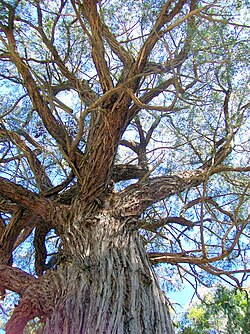    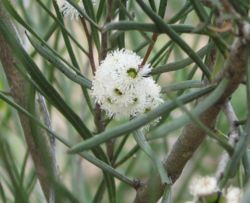       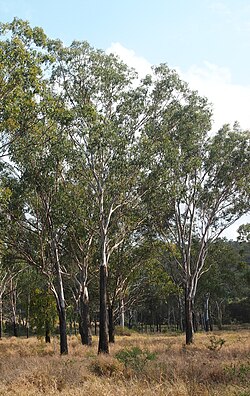      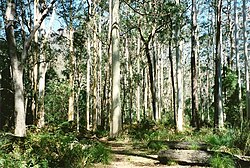          
|
Literatur
- John J. W. Coppen (Hrsg.): Eucalyptus: The Genus Eucalyptus (= Medicinal and Aromatic Plants – Industrial Profiles. Band 22). Taylor & Francis, London 2002, ISBN 0-415-27879-1 (englisch, XIII, 450 S., Inhaltsverzeichnis [PDF; 70 kB]).
Weblinks
- Die Eukalyptus-Website auf der Internetpräsenz der Australian Native Plants Society ANPSA. (englisch)
- Beschreibung in der Western Australian Flora. (englisch)
- Linksammlung des Centre for Plant Biodiversity Research.
- Systematik bei Euclid.
- Euclid – Webseite zur Verwandtschaftsgruppe der Eukalypten.
Einzelnachweise
- ↑ Daniel Lingenhöhl: Gigant auf Borneo entdeckt. In: Spektrum.de. 18. April 2019.
- ↑ Gatis Pavils: Centurion – the tallest eucalyptus tree. bei Wondermondo, 22. August 2010, abgerufen am 11. Oktober 2020 (englisch).
- ↑ Der höchste Baum der Welt. MonumentalTrees.com, 3. Dezember 2012, abgerufen am 26. Dezember 2022.
- ↑ a b c d Grupo Empresarial ENCE, S.A.: Sustainable Forest management and Eucalyptus. (PDF; 11,6 MB) ENCE Energía y Celulosa, 2009, S. 10, archiviert vom am 22. Februar 2015; abgerufen am 28. November 2018 (englisch).
- ↑ Andrew D. Thomas, Rory P. D. Walsh, Richard A. Shakesby: Nutrient losses in eroded sediment after fire in eucalyptus and pine forests in the wet Mediterranean environment of northern Portugal. In: Catena, Band 36, Nr. 4, 1999, S. 283–302.
- ↑ J. C. Z. Woinarski, J. Risler, L. Kean: Response of vegetation and vertebrate fauna to 23 years of fire exclusion in a tropical Eucalyptus open forest, Northern Territory, Australia. In: Austral Ecology, Band 29, Nr. 2, 2004, S. 156–176.
- ↑ Andrew Balmford: Wild hope – On the Front Lines of Conservation Success. The University of Chicago Press, London 2012, ISBN 978-0-226-03600-7, Pos. 1254.
- ↑ Stefan H. Doerr, Richard A. Shakesby, Rory P. D. Walsh: Spatial variability of soil hydrophobicity in fire-prone eucalyptus and pine forests, Portugal. In: Soil Science, Band 163, Nr. 4, 1998, S. 313–324.
- ↑ H. H. Shugart, I. R. Noble: A computer model of succession and fire response of the high‐altitude Eucalyptus forest of the Brindabella Range, Australian Capital Territory. In: Australian Journal of Ecology, Band 6, Nr. 2, 1981, S. 149–164, doi:10.1111/j.1442-9993.1981.tb01286.x.
- ↑ Oliver Neuroth: Waldbrände in Portugal: Noch immer wüten die Flammen. In: Tagesschau. ARD-Studio Madrid, 19. Juni 2017, archiviert vom am 22. Juni 2017; abgerufen am 20. Juni 2017 (auch Audio, MP3).
- ↑ Eucalypts: Eucalyptus, Corymbia, Angophora. Australian Native Plants Society (Australia), abgerufen am 30. Dezember 2022 (englisch).
- ↑ Grupo Empresarial ENCE, S.A.: Sustainable Forest management and Eucalyptus. (PDF; 11,6 MB) ENCE Energía y Celulosa, 2009, S. 7, archiviert vom am 22. Februar 2015; abgerufen am 28. November 2018 (englisch).
- ↑ Dominik Knapp: Die gängigsten Arten des Eukalyptus. In: Eukalyptusholz: Infos zu Farbe und Eigenschaften. HEROLD Business Data GmbH, abgerufen am 5. Januar 2022.
- ↑ Oleum Eucalypti, B.P. Oil of Eucalyptus. In: Pharmaceutical Society of Great Britain (Hrsg.): The British pharmaceutical codex, 1911. London 1911 (englisch, Transkript [abgerufen am 17. Dezember 2007] in Henriette's Herbal Homepage, Henriette Kress).
- ↑ Wisdom Koffi Adjawlo: Ghana: Eucalyptus plantations for producing energy, Mitteilung World Rainforest Movement vom 6. März 2020, abgerufen am 5. Jan. 2022.
- ↑ Terry Porter: Holz erkennen und benutzen. Hrsg.: HolzWerken. 2. Auflage. Vincentz Network GmbH & Co KG, Hannover 2018, ISBN 978-3-86630-950-0, S. 118.
- ↑ Charles Louis L'Héritier de Brutelle: Sertum anglicum, seu plantae rariores, quae in hortis juxta Londinum, imprimis in horto regio Kewensi excoluntur, ab anno 1786 ad annum 1787 observatae. Didot (u. a.), Parisiis (u. a.) 1788, Tafel 20, S. 11 (Latein, Tafel Text – bei biodiversitylibrary.org).
- ↑ Eukalyptus: Schreibung, Definition, Bedeutung, Etymologie, Beispiele. Digitales Wörterbuch der deutschen Sprache (DWDS), abgerufen am 26. Dezember 2022.
- ↑ L. D. Pryor, L. A. S. Johnson: A classification of the eucalypts. Australian National University, Canberra, Australia, 1971.
- ↑ Systematik nach Hill 1991:The Major Groups of Eucalypts – The Genera Eucalyptus, Corymbia and Angophora ( vom 5. April 2012 im Internet Archive)
- ↑ Murray Ian Hill Brooker: A new classification of the genus Eucalyptus L'Hér. (Myrtaceae). In: Australian Systematic Botany. Band 13, Nummer 1, 2000, S. 79–148, doi:10.1071/SB98008.
- ↑ O. C. Parra, M. Bayly, F. Udovicic, P. Ladiges: ETS sequences support the monophyly of the eucalypt genus Corymbia (Myrtaceae). In: Taxon, Volume 55, 2006, S. 653–663.
- ↑ EUCLID Species Index. In: Eucalypts of Australia, Fourth Edition. Centre for Australian National Biodiversity Research, CSIRO National Research Collections Australia, 2015, abgerufen am 30. Dezember 2022.
- ↑ Eucalyptus. In: POWO = Plants of the World Online von Board of Trustees of the Royal Botanic Gardens, Kew: Kew Science, abgerufen am 2. Oktober 2017.
Auf dieser Seite verwendete Medien
Autor/Urheber: Poyt448, Lizenz: CC0
Eucalyptus amplifolia bark, at West Pennant Hills, Australia
Struktur von 1,8-Cineol (Eucalyptol)
Autor/Urheber:
Genet (Diskussion).
Original uploader was Genet in der Wikipedia auf Deutsch, Lizenz: CC BY-SA 3.0Eucalyptus globulus - Fruits
Blaue Eukalyptus. A junger Schössling. B Blühender Zweig der Pflanze. 1 Knospe; 2 dieselbe im Längsschnitt; 3 geöffnete Blüte; 4 dieselbe im Längsschnitt; 5 Querschnitt durch die Staubbeutel; 6 Frucht. A B 1 2 3 4 6 natürliche Grösse, 5 vergrössert.
Autor/Urheber: ZDF/Terra X/S. Armsen/Marc Trompetter/Maximilian Heß, Lizenz: CC BY 4.0
Der australische Eukalyptus ist ein wahrer Wunderbaum. Er ist robust, anspruchslos und bringt Rekord-Erträge: bis zu 24 Tonnen Holz pro Hektar und Jahr, dreimal so viel wie ein mitteleuropäischer Laubwald.
Autor/Urheber: Melburnian, Lizenz: CC BY 2.5
Eucalyptus angustissima, Maranoa Gardens, Balwyn, Victoria, Australia.
Eucalyptus Chapmaniana (Bogong Gum) in Kew Gardens, London.
Autor/Urheber: Geoff Derrin, Lizenz: CC BY-SA 4.0
Operculum scar of Eucalyptus blakelyi
Autor/Urheber: rickjpelleg, Lizenz: CC BY-SA 3.0
Eucalyptus albens at the Ilanot national arboretum, Israel.
Autor/Urheber: Poyt448 Peter Woodard, Lizenz: CC0
Eucalyptus agglomerata, at Watagan Forest Road, Central Coast, NSW, Australia
Autor/Urheber: Die Autorenschaft wurde nicht in einer maschinell lesbaren Form angegeben. Es wird Dlanglois als Autor angenommen (basierend auf den Rechteinhaber-Angaben)., Lizenz: CC BY-SA 3.0
Description: Camden White Gum (Eucalyptus benthamii)
- Location: Australian National Botanic Gardens, Canberra, Australian Capital Territory, Australia
- Date: 2005-09-21
- Source: picture taken by Danielle Langlois
- Licence: Released under GFDL and Creative Commons licenses by the photographer
(c) Ethel Aardvark in der Wikipedia auf Englisch, CC BY 3.0
Eucalyptus crebra tree in coastal central Queensland, Australia.
Autor/Urheber: Poyt448 Peter Woodard, Lizenz: CC BY-SA 3.0
Eucalyptus grandis, Kerewong State Forest, NSW, Australia. 55 metres tall, photographed at the edge of a logging area. To one side was clear felled logging, the other side tall forest. Tree height measured with a Nikon forestry Laser Range finder 550.
Photographed at Maranoa Gardens, Melbourne, Victoria, Australia HelloMojo 08:08, 6 April 2007 (UTC)
Autor/Urheber: Tatiana Gerus from Brisbane, Australia, Lizenz: CC BY 2.0
My first load to Flickr this year. - my favourite Australian tree - Eucalyptus caesia - Silver Princess, or Gungurru (aboriginal name)
I felt in love with this tree from the first sight many years ago, when I saw it in Western Australia, where it is native to. It is absolutely charming elegant tree with weeping branches and amazing pink-red large pendant flowers in late winter-spring. The tree has distinctive thin silver-white coating on the buds, fruit and stems. (name caesia from Latin, caesius - light grey). It has attractive urn-shaped "gumnuts" (seedpods). Just beautiful graceful tree. asgap.org.au/e-cae.html
It does not grow in tropics, it would not grow in Brisbane. I photographed this tree late winter in Melbourn at returning from my skiing trip in Australian Alps.
I could not decide what shot to load, as I like all of them. I've loaded 4 photos. May be you let me know which one you like more. 1. Up on the sky - , 2. Silver Princess , 3. Weeping brunches , 4. Crackling flowers
All photos best to see larger of course :)Autor/Urheber: John Tann from Sydney, Australia, Lizenz: CC BY 2.0
Eucalyptus A, flower with buds. Gundaroo Common, Gundaroo NSW Australia, May 2013.
Photographed at en:Maranoa Gardens, en:Melbourne, Victoria, en:Australia HelloMojo 08:01, 6 April 2007 (UTC)
Photographed at Maranoa Gardens, Melbourne, Victoria, Australia by HelloMojo 09:01, 6 April 2007 (UTC)
Autor/Urheber: Raffi Kojian, Lizenz: CC BY-SA 3.0
Photographed at Huntington Gardens (Los Angeles) in April
Autor/Urheber: Sarefo, Lizenz: CC BY-SA 3.0
Natural world distribution of Eucalyptus, according to the book "Plant" (2005) ISBN 075660589X
en:Eucalyptus bridgesiana (Apple box ) tree photographed on en:Red Hill, Australian Capital Territory.
Family: Myrtaceae
Origin/Habitat: NSW to NE Vic, and Gippsland.
Foliage: Adult leaves 12-24cm, tapering to a fine point, green both sides, veins widely spaced. Juvenile leaves heart-shaped and stalkless, margins crenulate, grey green in colour.
Flowers: Jan-May. White in colour.
Other features for identification: Greyish in colour, scaly or short-fibred on trunk and large branches. Fruit 6-8mm in diameter, 3-4 triangular valves
The leaves are the colour of brownish orange(c) Forest & Kim Starr, CC BY 3.0
Eucalyptus deglupta (habit). Location: Maui, Hana Hwy
Autor/Urheber: Mark Marathon, Lizenz: CC BY-SA 4.0
Eucalyptus gamophylla
Photographed at Maranoa Gardens, Melbourne, Victoria, Australia by HelloMojo 08:12, 6 April 2007 (UTC)
Autor/Urheber: Sydney Oats, Lizenz: CC BY 2.0
Best viewed All sizes
Autor/Urheber: Arnaud Gaillard (arnaud () amarys.com), Lizenz: CC BY-SA 4.0
Koala. Foto wurde in Australien im März 1995 aufgenommen.
Photographed at en:Maranoa Gardens, en:Melbourne, Victoria, en:Australia HelloMojo 08:10, 6 April 2007 (UTC)
(c) Forest & Kim Starr, CC BY 3.0 us
Flowers and operculums at Ulupalakua, Maui, Hawaii. June 29, 2011
Photographed at en:Maranoa Gardens, en:Melbourne, Victoria, en:Australia HelloMojo 07:55, 6 April 2007 (UTC)
Autor/Urheber: Poyt448 Peter Woodard, Lizenz: CC0
Eucalyptus fraxinoides and sandstone at Mount Imlay, Australia
Seeds of Eucalyptus camaldulensis Dehnh.
Autor/Urheber: Poyt448 Peter Woodard, Lizenz: CC BY-SA 3.0
Blue Gum Forest, Blue Mountains National Park (NSW).
- Eucalyptus deanei trees.
(c) Photographs by Gnangarra...commons.wikimedia.org, CC BY 2.5 au
Avon Valley National Park
Eucalyptus accedens(Powder-barked Wandoo)Autor/Urheber: Sydney Oats, Lizenz: CC BY 2.0
Eucalyptus annulata. Flowers and Buds
(c) Ethel Aardvark in der Wikipedia auf Englisch, CC BY 3.0
Eucalyptus coolabah trees in the Fitzroy River floodplain, Queensland, Australia.
Autor/Urheber: Casliber, Lizenz: CC BY-SA 3.0
Eucalyptus bigalerita, planted at halfway roadhouse north of Perth toward Eneabba
Autor/Urheber: Proteaceous, Lizenz: CC BY-SA 3.0
Taken in Mt. Field National Park, around 1200m above sea level.
Autor/Urheber: Casliber, Lizenz: CC BY-SA 3.0
Eucalyptus erythrocalyx, somewhere up near Murchison River






